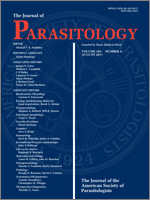Raillietina celebensis is a cestode that parasitizes the small intestine of rats and humans. Here, we detail the morphology and morphometry of R. celebensis based on specimens collected from Rattus norvegicus in the municipality of São Gonçalo, state of Rio de Janeiro, Brazil, by light and confocal scanning laser microscopies and also report the results of molecular phylogenetic analyses to determine its relationships within the family Davaineidae. Analysis of the number and size of testes, number and shape of rostellar hooks, cirrus sac length, capsules and eggs per capsule, and morphology of the mature proglottid allowed concluding that the present specimens constitute a new record of R. celebensis in South America. Our genetic and phylogenetic analyses, based on the partial small subunit 18S rRNA gene, revealed R. celebensis to be in the family Davaineidae within the genus Raillietina, in agreement with the morphological taxonomy. Phylogenetic trees obtained by neighbor-joining and maximum likelihood methods demonstrated R. celebensis as a unique taxonomic unit, and also demonstrated some taxonomic inconsistences. The incorporation of Brazilian R. celebensis sequences derived from mammals in the phylogeny of davaineids is consistent with the assertion that neither Raillietina nor Fuhrmannetta can be supported as distinct genera.
How to translate text using browser tools
1 August 2017
First Record of Raillietina celebensis (Cestoda: Cyclophyllidea) in South America: Redescription and Phylogeny
Raquel de Oliveira Simões,
Susana Balmant Enrique Simões,
José Luis Luque,
Alena Mayo Iñiguez,
Arnaldo Maldonado Júnior
ACCESS THE FULL ARTICLE

Journal of Parasitology
Vol. 103 • No. 4
August 2017
Vol. 103 • No. 4
August 2017




